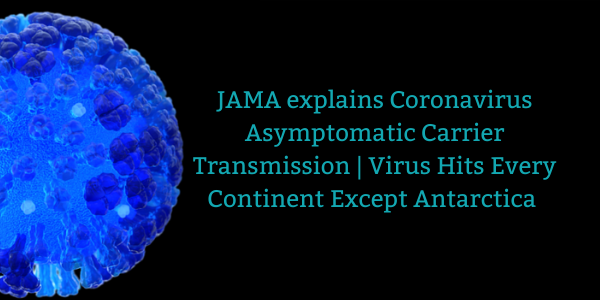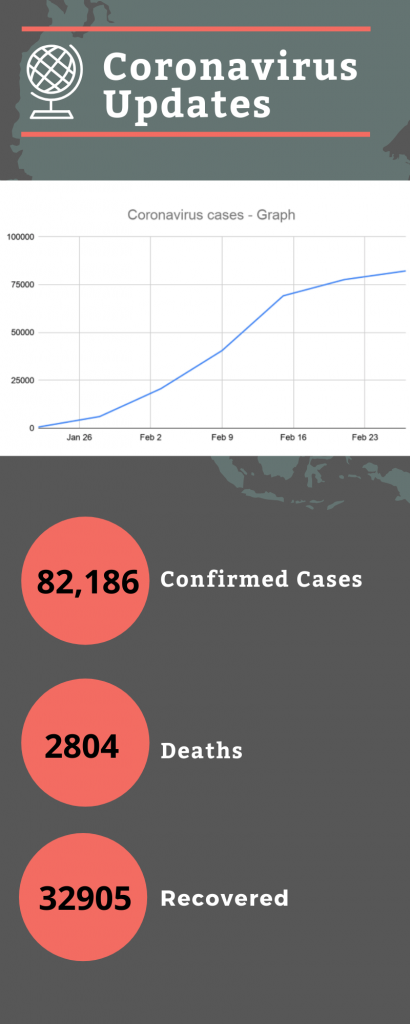
JAMA explains Coronavirus Asymptomatic Carrier Transmission | Virus Hits Every Continent Except Antarctica

As the coronavirus spread in Europe and beyond, with Latin America confirming its first patient, public health officials warned that the virus is moving towards the rendition of ‘global pandemic’.
Reporting first time in South America, Brazil has announced its first case of coronavirus. With this, the coronavirus has now reached six of the seven continents except Antarctica. The major outbreaks within the borders of Italy and Iran have turned deadly, and a top official from the US Centers for Disease Control and Prevention (CDC) warned that the US could see the virus spread within its borders. Dr Nancy Messonnier, the director of the CDC’s National Center for Immunization and Respiratory Diseases said: “Ultimately we expect we will see community spread in this country. It’s not so much a question of if this will happen anymore, but rather more a question of exactly when this will happen and how many people in this country will have a severe illness.”
At present, South Korea has the largest outbreak outside China. The country has reported 1200 cases and 12 deaths so far. Algeria, Croatia, mainland Spain and Switzerland announced their first confirmed cases. Iran’s health ministry has confirmed 139 cases and 19 fatalities. Italy has reported 374 cases and 12 deaths.

Though the World Health Organisation has held off on classifying the coronavirus’ spread as a global pandemic till now, the outbreak appears to be getting closer to a global pandemic.
According to the CDC’s Messonnier, the situation has met two of the criteria for a pandemic: “the fact that this virus has caused illness — including illness that has resulted in death — and sustained person-to-person spread.”
She also added that the world moves closer towards meeting the third criteria as the community spread is detected in more and more countries.
Possible Asymptomatic Carrier Transmission Reported
The JAMA Network has published a report revealing that asymptomatic carriers of coronavirus Covid-19 could transmit the virus. The study involves a 20-year-old woman from Wuhan who was not physically sick but passed the infection to five of her family members.
The report states “Patient 1 (presumed asymptomatic carrier), a 20-year-old woman, lives in Wuhan and travelled to Anyang on January 10, 2020. She initially met with patients 2 and 3 on January 10. On January 13, she accompanied 5 relatives (patients 2 through 6) to visit another hospitalized relative in Anyang District Hospital. There was no report of COVID-19 at this hospital. After the development of disease in her relatives, patient 1 was isolated and observed. As of February 11, she had no elevated temperature measured or self-reported fever and no gastrointestinal or respiratory symptoms, including cough and sore throat, reported or observed by the physicians. Chest CT images on January 27 and 31 showed no significant abnormalities. Her C-reactive protein level and lymphocyte count were normal. Results of RT-PCR testing were negative on January 26, positive on January 28, and negative on February 5 and 8.”
Patients 2 through 6 developed COVID-19. Four were women, and ages ranged from 42 to 57 years. None of the patients had visited Wuhan or been in contact with any other people who had travelled to Wuhan (except patient 1).
Patients 2 through 5 developed a fever and respiratory symptoms between January 23 and January 26 and were admitted to the hospital on the same day. All patients had RT-PCR test results positive for COVID-19 within 1 day. Patient 6 developed a fever and sore throat on January 17 and went to the local clinic for treatment. There was no report of COVID-19 at the clinic. Her symptoms improved over the next few days but worsened on January 24, when she was admitted to the hospital and confirmed to have COVID-19 on January 26. Two patients developed severe pneumonia; the other infections were moderate.
All symptomatic patients had multifocal ground-glass opacities on chest CT, and 1 also had subsegmental areas of consolidation and fibrosis. All the symptomatic patients had increased C-reactive protein levels and reduced lymphocyte counts.”
However, the clinical director of the National Centre for Infectious Diseases (NCID) Dr Shawn Vasoo said that there is no robust proof that the coronavirus can be spread by someone with no symptoms of the disease. Dr Vasoo said that as far as is currently known, “transmission is predominantly still through symptomatic persons”.
Some who are said to be “asymptomatic” may have “mild symptoms that people do not make much of”, he said.
Source: CNN, JAMA, Jakarta Post.
Bai Y, Yao L, Wei T, et al. Presumed Asymptomatic Carrier Transmission of COVID-19. JAMA. Published online February 21, 2020. doi:10.1001/jama.2020.2565